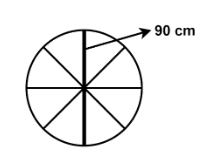
The wheel of railway carriage is 90cm in diameter and makes 3 revolutions in a second. How fast is the train going?
Answer
574.8k+ views
Hint: The distance covered by the wheel in revolution will be equal to its circumference. As speed is equal to $ \dfrac{{{\text{Distance}}}}{{{\text{Time}}}} $ , we can calculate the distance covered (in cm) in 1 second and get the speed in cm/s.
Complete step-by-step answer:

Therefore, radius $ = \dfrac{{90}}{2}{\text{ }}\left( {{\text{As radius}} = \dfrac{{{\text{Diameter}}}}{2}} \right) $ .
\[ = {\text{ }}45{\text{ }}cm\]
The circumference of the wheel is 2πr as it is circular in shape.
Substituting the values, we get:
\[2\pi r = 2 \times \dfrac{{22}}{7} \times 45\] $ \left( {\pi = \dfrac{{22}}{7}} \right) $
\[ = \dfrac{{1980}}{7}\]
$ = 282.85cm $
As, Distance covered in 1 revolution = circumference.
Distance covered in 3 revolution:
$ {\text{1 revolution = 282}}{\text{.85}} $
$ {\text{3 revoltuins = }}282.85 \times 3 $
$ = 848.75cm $
Since, 3 revolutions are made in 1 second, the distance covered in 1 second is 848.75 m.
Therefore, \[{\text{speed }} = \dfrac{{{\text{Distance}}}}{{{\text{Time}}}}\]
$ = \dfrac{{848.75{\text{ cm}}}}{{1{\text{ sec}}}} $
Thus, the speed of the train is 848.75 cm per second.
Note: One revolution made by a circular shape is always equal to its circumference.
Speed is specifically calculated as the distance covered in 1 second.
Generally, when the distance is given in km, the speed is measured in kilometre per hour (km/h) and when the distance is in m, the speed is measured in metre per second (m/s).
Complete step-by-step answer:

Therefore, radius $ = \dfrac{{90}}{2}{\text{ }}\left( {{\text{As radius}} = \dfrac{{{\text{Diameter}}}}{2}} \right) $ .
\[ = {\text{ }}45{\text{ }}cm\]
The circumference of the wheel is 2πr as it is circular in shape.
Substituting the values, we get:
\[2\pi r = 2 \times \dfrac{{22}}{7} \times 45\] $ \left( {\pi = \dfrac{{22}}{7}} \right) $
\[ = \dfrac{{1980}}{7}\]
$ = 282.85cm $
As, Distance covered in 1 revolution = circumference.
Distance covered in 3 revolution:
$ {\text{1 revolution = 282}}{\text{.85}} $
$ {\text{3 revoltuins = }}282.85 \times 3 $
$ = 848.75cm $
Since, 3 revolutions are made in 1 second, the distance covered in 1 second is 848.75 m.
Therefore, \[{\text{speed }} = \dfrac{{{\text{Distance}}}}{{{\text{Time}}}}\]
$ = \dfrac{{848.75{\text{ cm}}}}{{1{\text{ sec}}}} $
Thus, the speed of the train is 848.75 cm per second.
Note: One revolution made by a circular shape is always equal to its circumference.
Speed is specifically calculated as the distance covered in 1 second.
Generally, when the distance is given in km, the speed is measured in kilometre per hour (km/h) and when the distance is in m, the speed is measured in metre per second (m/s).
Recently Updated Pages
Master Class 10 General Knowledge: Engaging Questions & Answers for Success

Master Class 10 Science: Engaging Questions & Answers for Success

Master Class 10 Social Science: Engaging Questions & Answers for Success

Master Class 10 Maths: Engaging Questions & Answers for Success

Master Class 10 English: Engaging Questions & Answers for Success

Master Class 10 Computer Science: Engaging Questions & Answers for Success

Trending doubts
What is BLO What is the full form of BLO class 8 social science CBSE

Citizens of India can vote at the age of A 18 years class 8 social science CBSE

Full form of STD, ISD and PCO

Right to vote is a AFundamental Right BFundamental class 8 social science CBSE

Summary of the poem Where the Mind is Without Fear class 8 english CBSE

What are gulf countries and why they are called Gulf class 8 social science CBSE




